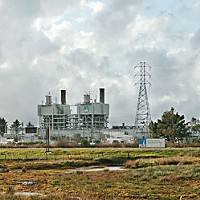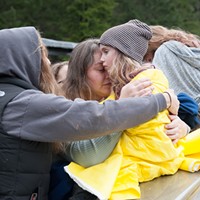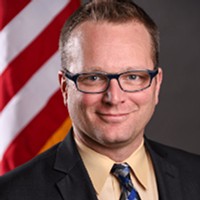BLACKOUT
Humboldt County emerges from 28 hours of darkness to confront an uncomfortable reality
By North Coast Journal Staff[
{
"name": "Top Stories Video Pair",
"insertPoint": "7",
"component": "17087298",
"parentWrapperClass": "fdn-ads-inline-content-block",
"requiredCountToDisplay": "1"
}
]
It was 5:22 a.m. on Tuesday, Oct. 8, when Dorie Lanni's cell phone rang. It had already been a hectic 36 hours for Lanni, the county's emergency services manager tasked with running the three-person office that coordinates major emergency responses in Humboldt County.
The prior Sunday, she'd joined a 6 p.m. conference call hastily assembled by Pacific Gas & Electric Co. On the line were Office of Emergency Services (OES) managers from 39 counties, as well as a host of other officials, when PG&E announced it was going to be initiating the first of its long predicted Public Safety Power Shutoffs (PSPS). The company didn't have details but was providing first notice that it was monitoring wind and humidity patterns and expected elevated fire conditions in the coming days that would force it to shut down portions of its electrical grid, potentially cutting power to customers in some or all of the 39 counties. Everyone on the line was asked to call in the following morning for a follow-up conference at which PG&E would have more information.
"At that point, I wasn't really concerned," Lanni says a week later, sitting in the county's Emergency Operations Center, a bunker-like room in the basement of the county courthouse that, save for some computer equipment and a large television monitor, looks like it hasn't changed in 50 years.
Lanni, too, had been monitoring local fire conditions — she says it comes with the job — and knew they weren't expected to be elevated throughout much of the county. At most, she figured, residents along some blustery ridgelines or in the drier reaches of the eastern part of the county may be impacted. Nonetheless, she pushed out an email to 400 partner agencies — first responders, hospitals, municipalities and others — to alert them.
At 8:30 a.m. Monday, Lanni joined the PG&E call and was mildly relieved to get the news she expected.
"I was told Humboldt County is no longer included. They said, 'You will not be impacted,'" Lanni says, adding that it was a message repeated throughout the day until the last PG&E conference call Monday night.
Then came the call Tuesday morning from a PG&E employee.
"He said, 'I was told to call you and tell you you're back in the scope. Be on a call at 7:30," Lanni says.
The 7:30 a.m. call was somewhat chaotic, Lanni says, but wrapped with PG&E listing the numbers of customers it expected could be impacted in each county. When it came to Humboldt, a company representative said 60,000 customers could potentially be left without power as of midnight, with the outage potentially lasting through the weekend. Lanni was floored.
"We have been talking with PG&E for at least two years, at no point did they ever suggest in any way that we might lose power to the entire county," Lanni says, adding that each and every conversation had been about localized shutoffs in response to localized fire conditions.
After the call wrapped, Lanni scrambled to follow up with PG&E employees and eventually learned that because the two transmission lines that run along state routes 299 and 36 bringing PG&E's electricity into Humboldt County originate in Shasta County, which was slated to be shutdown due to forecasts of high fire risk, there would be no way to get electricity into Humboldt. This was the first time Lanni and other Humboldt County officials learned of this reality, she says.
"We have no idea if that's because they didn't know or they just decided not to share that information with our first responders," she says, adding that over the course of two years she had repeatedly requested access to maps detailing how PG&E's power grid in Humboldt County operates, only to be told that would present a security risk.
Throughout the day, Lanni says she was told by PG&E that Humboldt County might be impacted but might not, and the company was "working on solutions." To make matters worse, thinking Humboldt County would not be affected, PG&E had sent some of its local crews out of the area to help in other counties that were slated to be shut down.
Lanni says she would later learn that the solution PG&E had spent the day scrambling to assess was powering the county through the Humboldt Bay Power Plant in King Salmon, which generates electricity by burning natural gas. But that was never viable as the plant was never designed to stand alone and requires power from an energized grid to operate. According to PG&E spokesperson Megan McFarland, the company has an engineering study underway to evaluate what modifications would be needed to make the plant stand alone but it's unclear why PG&E's higher ups thought — or at least said — these modifications could have been made on the fly.
"The time that was wasted exploring solutions that were never viable could have been used working with locals on things that would have helped," Lanni says, adding that ruling out that potential "solution" could also have resulted in residents getting an additional 10 hours of definitive notice.
It wasn't until after 6 p.m. that Lanni got official word that the entirety of Humboldt County would lose power after midnight. She asked when and was told PG&E didn't know.
"They really didn't know," she says, still somewhat mystified. "They didn't know what areas would be out and at what time."
And even after the county got official word that Humboldt would go dark, Lanni says PG&E representatives continued to give out conflicting information to lawmakers and residents. It was chaos.
For Lanni, someone who is used to gathering and disseminating information in times of emergency, the situation was hugely frustrating.
"We were at the mercy of a corporation to get vital information," she says. "They were getting a lot of requests for information from everyone all at the same time and they were not at all prepared for that kind of informational flow."
'PG&E be Damned'
While confusion seemed to reign for most of Oct. 8, with locals receiving conflicting reports, the most serious of which were that the county "may" lose power, a palpable fear took hold shortly after 7 p.m., when OES sent out an alert to 51,000 people definitively saying Humboldt would go dark.
Shortly before 8 p.m. in a line five or six people deep at an ATM machine in Old Town, people chatted about preparations. One man worried about how he would keep his reptiles warm at home. When one customer withdrew some cash and wished everyone good luck before walking off, another said, "If you have a gun, I suggest you carry it."
Across town at WinCo Foods, lines stretched the length of the store to the meat market, with customers frantically trying to stock up on water and supplies. The ice was going quickly, so some customers grabbed it first before continuing their shopping, leaving trails of melted ice through the aisles. Mike Howton said his household was pretty well prepared, stocked with camping gear and supplies, but his girlfriend ran to WinCo to pick up a few last-minute things — not more than a shopping bag of groceries. She was there for an hour and a half.
Similar scenarios played out throughout the county, as shelves were stripped bare and people waited up to an hour to gas up their vehicles.
Humboldt County lost power in waves, between roughly 12:50 and 3:30 a.m. Later in the morning, a smattering of stores opened around town on generator power to deal with the throngs of people still looking for food and supplies.
That afternoon, about 12 hours into the outage, the Safeway on Harris Street in Eureka had largely been stripped bare. Ryan Vodden, who'd tried to buy food at Murphy's Market earlier only to find its shelves bare, walked in to find the same at Safeway.
"I was hoping to find some food in the deli," he said, pointing to empty shelves and cases. "But everything's cleared. Now, I'm just wondering where the zombies are."
Down Harris Street, there was a flurry of activity at the Harris and K Market, which had a pickup truck sitting out front, its bed filled with bagged ice. A line quickly formed as people parked their cars and ran in. The store's owner, Cameron Renner, said he started ordering pallets of ice from his distributor the day before and used his truck to run them back and forth.
With a line stretching out the door, Rebecca Chittenden said she had gone shopping before the outage and had a month's worth of food at home that was in danger of spoiling. But she was more worried about the children at Grant Elementary School where she works, saying it had been forced to throw away food and she wasn't sure what it would do for school lunches if the blackout continued.
Across Eureka, in Old Town around 2 p.m., a chalkboard sign stood in front of the Shanty bar, reading "PG&E be Damned, We're Open." Inside, a couple dozen patrons sat in the bar, which was dim, lit only by some sunshine pouring through the windows and open doors. The soda machine wasn't working but the liquor was flowing as people chatted pleasantly and passed the day. At one of the cocktail tables, Ceci Walker and Dave Orchard sat talking and sipping their drinks.
"It's kind of like a weird Christmas break," Orchard said with a smile.
Walker, meanwhile, said she couldn't stop thinking about the small business owners and minimum wage employees already struggling to get by who would now face missed paychecks and added expenses. (According to the Greater Eureka Area Chamber of Commerce, about 45 percent of its member businesses closed as a result of the outage.) Walker also said she worried about the kids whose only solid meals are at school through free and reduced lunch.
"It feels like an extension of the class warfare that's gripped the country," said Walker, who works remotely for a company that manufactures mounts for solar panels. "I'm hoping this will make people aware they should put solar on their homes. Screw the man."
A couple of blocks away, the Eureka Rescue Mission was scrambling to figure out how it would feed and shelter more than 100 homeless people for the night with temperatures expected to drop below 40 degrees.
Visible Deterrents
When the Chevron gas station on J Street in Arcata got word of the outage, its owners knew it wasn't going to be able to pump gas but staffed for the day anyway. Mark Nelson said he and another employee were there to call 911 in case anyone tried to loot the place. But things were quiet, he said, so they just gave away ice cream that would have melted, saying they gave out "close to 100 gallons" and urged stressed out people to relax.
Throughout the county, police agencies scheduled extra patrols to provide a visual deterrent and keep an eye on things. But they were also cautious not to call all hands on deck, wanting the effort to be sustained should the blackout stretch on for days.
In Arcata, Chief Brian Ahearn made sure his officers patrolled back alleys and deeper into neighborhoods than normal.
Eureka Police Chief Steve Watson said the city saw five car crashes during the outage, "which was more or less on par with the regular rate" despite the city's stoplights blinking red or being out entirely. The city's public works department was quick to put out stop signs at intersections with down lights, Watson said, which likely helped. Additionally, the chief said non-sworn city staff did the rounds in city trucks with amber lights on top to serve "as visible deterrents as well as another set of eyes."
Watson said a liquor store was also broken into, with some cigarettes and scratcher lottery tickets stolen, and there was an altercation at a gas station. Overall, though, he said the night was pretty much "in line of what we typically see."
Sheriff William Honsal said his office, too, increased patrols and took precautions — like staging its mobile command center to deploy and working with jail staff to prepare for criminal hearings in a makeshift court to protect public safety and honor inmates' constitutional rights, should the blackout have extended.
But mostly things went smoothly from a law enforcement perspective, Honsal and the chiefs said, though they responded to a number of fire and burglar alarms triggered by the outage. While there were considerable inconveniences and economic losses locally, Honsal said it's important to keep some perspective on why the county went dark.
"I guarantee that anyone who went through a devastating fire would give up four days of power to have their communities back," he said.
Not everyone, however, is buying the blackout-or-fire choice. At an Oct. 10 community meeting in Blue Lake, state Sen. Mike McGuire made clear that he feels PG&E's lack of infrastructure investment over the years — which included its decision to pay $4.5 billion in shareholder dividends instead of trimming trees to prevent wildfire, according to federal Judge William Alsup — is to blame for the elevated fire risk.
"Other utilities in Southern California have moved forward aggressively with vegetation management around their lines, replacing old and decaying poles, harden the actual electrical lines and modernize them," McGuire said. "PG&E has not, so we're seeing these massive outages as a last-ditch effort not to start a large wildfire."
'Their Diesel'
More than flashlights, D batteries or food, the single item that came most desperately in demand during Humboldt County's 28 or so hours in the dark was fuel. And it wasn't just residents scrambling to gas up at the handful of pumps that continued operating on backup power.
Most diesel fuel on the North Coast passes through a bottleneck — the terminal on Truesdale Street owned and operated by Chevron, which barges fuel into the county. Although a few gas suppliers truck in fuel, most stations purchase it from Chevron and re-sell it under their own brand names. But Chevron pumps its fuel from its massive storage tanks through electrical power and — apparently — does not have a backup generator. So when the power went off last week, so did the county's primary fuel supply.
Lanni said plainly that OES was not prepared for this.
"We were unaware that Chevron wouldn't be able to distribute fuel as a result of this outage," she says.
So, it seems, was most everyone else. And what most people don't realize is that diesel is the lifeblood of most of the backup infrastructure in the county, as it runs the generators that power cell towers, sewage systems, water pumps, fire stations and more.
The Humboldt Bay Municipal Water District, which sells water to the bulk of Humboldt County residents, including those in Eureka, Arcata and McKinleyville, was unprepared for how scarce diesel would become.
HBMWD Operations Manager Dale Davidsen says the district keeps enough diesel fuel on hand to keep the generators at the water plant going for three or four days, an "adequate supply for a typical wintertime outage." But upon hearing this outage may go longer, he had to scramble.
The district purchases its fuel from Valley Pacific Petroleum Services Inc., which took over Renner in 2016 and only keeps a limited stock of fuel on hand. When Davidsen tried to order more fuel in the midst of the blackout on Oct. 9, he was told he was getting the last tank. There was more fuel "in the area," but it was inaccessible in Chevron's tanks.
At the district board meeting, Director Bruce Rupp wondered if in a "real emergency," the mayor of Eureka or someone could declare an emergency and "tell Chevron we're going to take their diesel."
Norman Crum, Valley Pacific's president, told the Journal that Renner had been caught flat-footed by the blackout but was doing a "postmortem" to see what had gone wrong and how it could be better prepared next time.
"We only heard that it maybe, might happen," he said. "If we had known something more definitive, we would have been prepared, would have topped off all our facilities."
Crum confirmed that Chevron's tanks were "locked down tight" and that nobody could refuel during the blackout, adding that safety regulations likely prohibited Chevron from using a generator to power its terminal, which is why the company reportedly rejected many an offer from third parties to bring in generators.
An Island in the Storm
If the blackout exposed Humboldt County's near complete dependence on PG&E for power, it also showcased a local model of sustainability: Blue Lake Rancheria.
Using a microgrid system built in collaboration with the Schatz Energy Research Center with the help of a state grant, the Rancheria was not only able to keep its hotel up and running through the blackout, it also gassed up thousands of vehicles, distributed thousands of bags of ice and opened a community respite center that allowed people to charge their phones and medical devices.
Sustainability Director Jana Ganion says the grid works on a complex mix of solar power, large-scale lithium-ion batteries and diesel generators that, together, allow the Rancheria to seamlessly sever itself from the PG&E grid and operate as an island when an outage occurs. In this case, Ganion says, 75 percent of the energy used came from the sun.
"The systems themselves worked beautifully, seamlessly," she says of their first real test in an emergency situation.
And the Rancheria didn't just use the backup power to continue operations as normal. It became a community hub. Perhaps most notably, Ganion says the backup system allowed the Rancheria to keep its gas station operating and it worked with fuel suppliers to keep its tanks filled. While it had to ration at times — capping customers' purchases at $20 or $50 — it never ran out of fuel and had a steady line of vehicles waiting to gas up from about 8 p.m. on Oct. 8 to 9 p.m. the following night.
The Rancheria also worked directly with the county Department of Health and Human Services and held rooms at the hotel, which sold out almost immediately as word spread of the blackout and had a waiting list 40 names long, for eight of the county's most vulnerable charges, allowing them to stay in rooms with a reliable source of electricity to power their medical devices.
"They credit us with saving lives," Ganion says. "That's one of the things we get a little emotional about."
The Rancheria's hotel also turned into a small ice factory, as it was one of the only places in the county with large-scale ice machines, reliable water and power, and enough staff to constantly make and bag ice. While it at times had to limit customers to two bags apiece, Ganion says the Rancheria was able to offer ice without disruption until around 4 p.m. Wednesday when it ran out and decided to strategize to build up reserves by morning.
At the community respite center, residents could come keep warm, get some food and water, do homework or even watch some cartoons on a big screen.
Perhaps most importantly, the Rancheria also sent out word that it would prioritize first responders for fuel, and even set aside 100 gallons for the Mad River Fish Hatchery, which was in danger of running out of gas for its backup generator and losing its fish stock, as well as some for United Indian Health Services, which needed to keep its generators going overnight to keep medications cool.
Ganion says the Rancheria was very happy to be there to support the local community and to showcase the virtues of a "climate smart economy." Asked about the Rancheria's contributions, Lanni at OES did not mince words: "Blue Lake Rancheria was a superhero through all this."
The Most Vulnerable
Throughout the day Oct. 8 and well into the early morning of Oct. 9, Lanni said DHHS personnel scrambled to make sure its most vulnerable clients in Adult Protective Services and Child Welfare Services were cared for. They triaged to prioritze contacting those with medical devices that relied on electricity.
DHHS spokesperson Heather Muller said the department started planning when it first heard from PG&E that public safety blackouts may become a reality.
"We started to look at these people who would be most impacted and who would take care of them, and we realized, that's us," she says.
So they identified their highest risk clients — more than 130 of them — and contacted them. When they couldn't reach someone by phone, a staffer drove to their home. In some cases, they delivered extra supplies. They worked with Humboldt Bay Fire to open a charging station where people could take their medical devices, and Calfire Chief Kurt McKray offered to conduct welfare checks on clients who lived outside the Eureka area.
Similar efforts were underway at Resolution Care, which provides palliative care, and Hospice of Humboldt, both of which scrambled to get supplies to patients in need. Because Hospice's facility has generator power, it was able to move some patients who needed electricity for their devices from their homes to spare rooms.
But as the blackout stretched later into Oct. 9, one glaring problem became clear to all local medical providers: There was a shortage of oxygen and if the blackout had stretched on another day, there wouldn't have been anywhere within Humboldt County to fill a tank, which would have had disastrous consequences.
In Arcata, meanwhile, Arcata House Partnership kicked into gear to make sure nobody went hungry during the blackout, making lunch and dinner available to anyone who needed it. For those homebound, the nonprofit partnered with the Arcata Police Department to deliver meals. Noting that the nonprofit that primarily focuses on housing served more than 1,000 meals over the course of two days, Executive Director Darlene Spoor told the Journal she was "beaming with pride at the work we did."
To the south, the Eureka Rescue Mission scrambled to keep its doors open. The nonprofit had to jury-rig borrowed generators to keep some of its refrigerators working. After it issued a plea for working flashlights on Facebook, Eureka Main Street Executive Director Charlotte McDonald showed up with a few dozen she'd picked up at Costco. A community member donated two huge pots of soup broth and some meat, according to Mission Executive Director Bryan Hall Sr., and Food for People delivered five big boxes of eggs, so the mission was able to feed roughly 130 people soup and egg sandwiches the night of Oct. 9, when temperatures dropped to 36 degrees and the county issued its first extreme weather warning of the year.
"We do serve some very vulnerable people and they really depend on us and it's just good to have the community behind us and supporting us," Hall says. He noted that he's still "in scramble mode" trying to plan for the next outage, adding the mission needs a large three-phase generator and some electrical work to be truly prepared.
While those who care for Humboldt County's most vulnerable expressed relief and no small degree of pride that they'd navigated the power outage well, they said there's a lot of work to be done to adequately prepare for the next.
"This blackout was a wakeup call," said Resolution Care Director of Compliance Amy Bruce.
The Little Hospital that Could
When lights throughout Arcata flickered off at 12:53 a.m. Oct. 9, Mad River Community Hospital's stayed on. Some of them, anyway.
The hospital began planning as though the power outage would be a certainty shortly before noon the day before, readying its generators and going over operational plans. As a result, the hospital was able to keep virtually all its services up and running for the public, including its emergency room and trauma center. And because the hospital's Radiology Department stayed open, including its CT scan equipment, it was receiving transfers who needed imaging work done from St. Joseph Hospital.
Working with a hodgepodge of extension cords powered by a trio of generators, hospital staff had to scramble to rearrange patient rooms, most of which only had one outlet serviced by the generator. They laid down power strips, rationed linens and, in some cases, worked by lantern light.
Critical Care Manager Tina Wood says the hospital treated eight serious cases that came as a result of the blackout: two fall victims and six people with breathing trouble, all related to the electrical outage, one of whose condition decompensated rapidly and had to be flown out of the area for further treatment. The hospital also received one trauma patient — a pedestrian hit by a car in Orick — who also had to be flown out of the area.
At an after-action review meeting of department heads Oct. 14, there was an evident feeling of pride as staff reported that nobody was turned away from the hospital as result of the blackout. Even the outpatient lab kept all its appointments, though one MRI needed to be rescheduled for another day.
The hospital's gift shop turned into an ersatz information center, where community members came and called with questions, and the hospital's cafeteria switched to its emergency menu but offered sandwiches and soup to anyone, including community members who came in by the hordes and, in some cases, left loaded up with takeout boxes for their families. The one notable problem is that there was reportedly about a 20-minute period without coffee.
"We were not able to keep up with the coffee," says kitchen manager David Lewis. "I've never seen anything like it."
But much of the conversation on Oct. 14 was forward looking, focused on how the hospital can be better prepared next time. The hospital had 820 gallons of diesel fuel on site and ran through it at a rate of about 10 gallons per hour, staff reported, meaning it could have gone about 82 hours without reinforcements or powering down some operations. Jed Rudd, the hospital's director of ancillary services and safety, said they had been able to get a line on more fuel from Renner but it was dicey amid the shortage. Clinical staff noted that while the hospital had enough linens for four days, it was forced to ration them, which could have become a problem because staff uses heated blankets as a primary way to keep patients warm and the hospital was freezing cold without power.
Pamela Floyd, the hospital's director of risk and compliance, told department heads Oct. 14 that she was very pleased with how the entire staff responded to something it had never faced before.
"It was just super calm walking through the hospital," she said. "When the lights went out, ours stayed on."
Two Weeks?
Sitting in the county's Emergency Operations Center several days after power was restored countywide, Lanni says she wants the community to know she's frustrated. She's frustrated that the county wasn't able to better prepare and that it wasn't able to get community members accurate information in a timely fashion.
She points to the announcement OES made the morning of Oct. 9, roughly eight hours after the county had lost power. It said PG&E was opening two community resource centers — one at College of the Redwoods and one at Redwood Acres Fairgrounds — where residents could go for drinking water and to charge phones and medical devices. Within minutes of the announcement, PG&E sent out a press release saying it was only opening one — at Redwood Acres — and it wouldn't be open until 8 a.m. the following day.
"We released what PG&E told us and they immediately released something different," she says. "It was really frustrating. It also reduced our confidence in the information we were getting."
It's worth noting that by the time PG&E opened the center at Redwood Acres, power had been restored throughout Eureka for hours but much of the eastern edge of the county — including Hoopa, Willow Creek and Orleans — remained powerless. Hoopa had requested a community resource center, Lanni says, but PG&E opted not to locate one there. OES was consulted, too, she says.
"I don't know why we were even contacted because they ignored our advice, so it was just a waste of time," she says.
But mostly, Lanni says she wants this to serve as a wake-up call for Humboldt County. As rough as 28 hours in the dark were, she says it's important to realize the rate at which things could deteriorate if an outage stretched to 48, 72 or 96 hours. There would be a domino effect, she says, as backup systems reliant on batteries or diesel generators began to fail. First the blinking stoplights would stop, then maybe cell service, followed potentially by sewage and drinking water.
"Nobody had the backup infrastructure in place to meet the demand we knew would overwhelm us," she says, stressing that, while Humboldt County received very short notice, this was to some extent a planned event, as opposed to a massive earthquake, which could cripple infrastructure and leave the area without power for weeks, while also flooding hospitals with injuries.
So it's important the county start having some real discussions about investing in its emergency infrastructure on all levels, Lanni says, and that begins at home.
"I really hope that this is a wake-up call for us as a community that we are independently responsible for taking care of our ourselves and our families," she says. "Everyone should think about what if this had gone on for three or four days or two weeks. Every person or household that is prepared for something like this is one less we have to worry about."
Weigh in
The city of Eureka and the county Office of Emergency Services are looking for help assessing the impact of the Oct. 9 PG&E blackout. The city is asking all businesses to email information losses incurred to The county is asking residents to fill out a survey, which can be found https://bit.ly/21Q9knd.
The Journal's Jennifer Fumiko Cahill, Iridian Casarez, Kali Cozyris, Thadeus Greenson, Sam Leishman and Kimberly Wear, as well as freelance journalist Elaine Weinreb, contributed to this report.
Speaking of...
Comments (2)
Showing 1-2 of 2
more from the author
-
Catherine Ellen Barnes
August 31, 1950- March 13, 2024
- Jul 15, 2024
-
Gary Lee Markussen Jr.: 1951-2024
- Jul 14, 2024
-
David Keith Boston: 1951-2024
- Jul 14, 2024
- More »
Latest in News
Readers also liked…
-
Through Mark Larson's Lens
A local photographer's favorite images of 2022 in Humboldt
- Jan 5, 2023
-
'To Celebrate Our Sovereignty'
Yurok Tribe to host gathering honoring 'ultimate river warrior' on the anniversary of the U.S. Supreme Court ruling that changed everything
- Jun 8, 2023











































